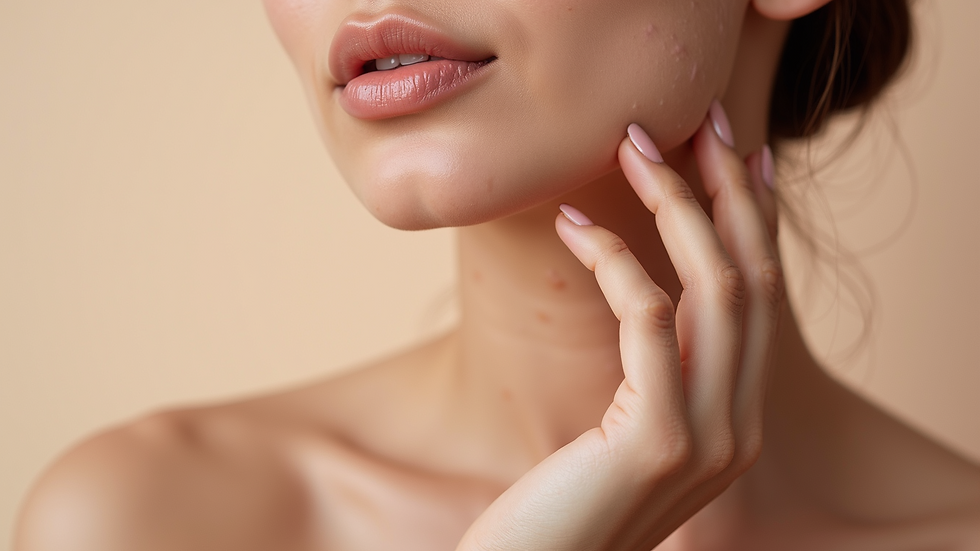What to Expect from a Chemical Peel for Your Skin
- sangeetakhetpal
- Oct 13
- 4 min read
Chemical peels have become a popular skincare treatment for those looking to rejuvenate their skin and address various concerns such as acne scars, uneven texture, and signs of aging. If you are considering this procedure, it’s important to understand what it involves, how it works, and what results you can expect. This guide will walk you through everything you need to know about chemical peels.
Understanding Chemical Peels and Their Benefits
Chemical peels involve applying a solution to the skin that causes the outer layers to exfoliate and eventually peel off. This process reveals fresher, smoother skin underneath. There are different types of chemical peels, ranging from superficial to deep, depending on the strength of the acids used and the depth of skin penetration.
Types of Chemical Peels:
Superficial Peels: Use mild acids like alpha-hydroxy acid (AHA) to gently exfoliate the outermost layer of skin. Ideal for mild skin discoloration and rough texture.
Medium Peels: Use trichloroacetic acid (TCA) to reach the middle layers of skin. Effective for treating wrinkles, acne scars, and uneven skin tone.
Deep Peels: Use phenol or stronger acids to penetrate deeper layers. These are used for more severe skin issues but require longer recovery.
Benefits of Chemical Peels:
Improves skin texture and tone
Reduces fine lines and wrinkles
Treats acne and acne scars
Minimizes age spots and sun damage
Stimulates collagen production for firmer skin

What Happens During a Chemical Peel?
Before the procedure, your skin will be thoroughly cleansed to remove oils and dirt. The chemical solution is then carefully applied to your face using a brush or cotton applicator. You may feel a slight tingling or burning sensation, which usually lasts a few minutes.
The solution works by breaking down the bonds between dead skin cells, causing them to loosen and peel away over the next few days. The depth of peeling depends on the type of peel used.
After the application, the solution is neutralized or washed off, and a soothing moisturizer or sunscreen is applied to protect the skin. The entire process typically takes 30 to 60 minutes.
Important tips for the procedure day:
Avoid wearing makeup before your appointment
Inform your provider about any skin conditions or allergies
Follow pre-treatment instructions carefully to prepare your skin

How Long Does a Chemical Peel Last?
The effects of a chemical peel can vary based on the type of peel and your skin type. Superficial peels may require multiple sessions spaced weeks apart to achieve desired results, while medium and deep peels often show more dramatic improvements after just one treatment.
Duration of Results:
Superficial Peels: Results can last several weeks to a few months. Regular maintenance treatments are recommended.
Medium Peels: Effects may last up to a year or longer with proper skincare.
Deep Peels: Long-lasting results, often several years, but require significant downtime and aftercare.
Recovery Time:
Superficial peels usually have minimal downtime, with slight redness and peeling lasting 2-5 days.
Medium peels may cause redness, swelling, and peeling for up to 2 weeks.
Deep peels require the longest recovery, with redness and peeling lasting several weeks.
Proper aftercare is essential to maintain results and protect your skin from sun damage. Use gentle cleansers, moisturizers, and broad-spectrum sunscreen daily.

Preparing for Your Chemical Peel Treatment
Preparation is key to a successful chemical peel experience. Your skincare professional may recommend a pre-treatment regimen to optimize your skin’s condition. This can include:
Using gentle exfoliants or retinoids to promote cell turnover
Avoiding sun exposure and tanning beds for at least two weeks before treatment
Discontinuing certain medications or skincare products that increase sensitivity
On the day of your appointment, arrive with a clean face free of makeup or lotions. Discuss any concerns or questions with your provider to ensure you feel comfortable and informed.
After the peel, follow all aftercare instructions carefully. This may include:
Avoiding direct sunlight and wearing protective clothing
Applying prescribed ointments or moisturizers
Refraining from picking or peeling the skin manually
Is a Chemical Peel Right for You?
Chemical peels can benefit many skin types and concerns, but they are not suitable for everyone. People with certain skin conditions such as eczema, psoriasis, or active infections should avoid peels. Additionally, those with darker skin tones should consult with a professional experienced in treating diverse skin types to minimize the risk of pigmentation changes.
If you are looking to improve skin texture, reduce fine lines, or address acne scars, a chemical peel might be a great option. Always seek treatment from a licensed and experienced skincare professional to ensure safety and optimal results.
For those interested in exploring this treatment further, consider scheduling a consultation to discuss your skin goals and determine the best peel type for you. You can learn more about chemical peel treatment options and what to expect during your visit.
Enhancing Your Skincare Routine Post-Peel
After your skin has healed, maintaining a consistent skincare routine is crucial to prolong the benefits of your chemical peel. Here are some actionable recommendations:
Hydrate: Use a gentle, hydrating moisturizer to support skin barrier repair.
Protect: Apply broad-spectrum sunscreen with SPF 30 or higher every day.
Avoid Harsh Products: Steer clear of abrasive scrubs, retinoids, or acids until your skin fully recovers.
Gentle Cleansing: Use mild cleansers that do not strip natural oils.
Regular Maintenance: Schedule follow-up treatments or peels as recommended by your skincare provider.
By following these steps, you can enjoy smoother, brighter, and healthier skin for months to come.
Chemical peels offer a powerful way to refresh your complexion and address a variety of skin concerns. Understanding the process, recovery, and aftercare will help you make an informed decision and achieve the best possible results. Whether you choose a superficial peel or a deeper treatment, professional guidance and proper care are essential for glowing, rejuvenated skin.



Comments